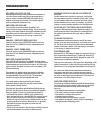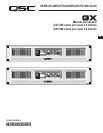
TROUBLESHOOTING
10
EN
NO POWER, NO LIGHTS, NO FAN
Conrm that the AC cord is fully seated and connected to a
live outlet. Check the AC source by trying another device
such as a lamp. Check the BREAKER on the back of the
amplier by pushing in the button. If the breaker trips off
quickly, the amplier needs servicing.
AMPLIFIER LOSES VOLUME
If the amplier is worked too hard, GuardRail™ will
reduce volume to prevent thermal muting. The fan should be
running at full speed. Reduce input signal somewhat and the
amp should return to normal gain within 1-2 minutes. If the
amp feels hot and the fan is not running, it needs to be
serviced.
CHANNEL 1 PRODUCES DEEP BASS ONLY.
Check the position of the CROSSOVER switch on the rear
panel. Set on FULL RANGE for normal, independent use of
each channel.
CHANNEL 2 INPUT SEEMS DEAD.
Check the position of the CROSSOVER switch on the rear
panel. Set on FULL RANGE for normal, independent use of
each channel.
AMPLIFIER SOUNDS DISTORTED.
If the red CLIP LED is ashing, the amplier is being played
beyond its normal rated power. GuardRail™ circuitry will reduce
volume somewhat to prevent severe overdrive, but if the input
signal is further increased, the limiter can be overridden, with
increased distortion.
If the speakers or speaker cables are shorted or defective,
the amplier may distort at lower-than-normal levels, with
increased ashing of the red CLIP LED. This should be
checked by trying an alternate speaker and cable.
If too many speakers are connected to each channel
(impedance below 4 ohms), the amp will overload more
easily and will probably run hot.
If the sound is distorted or garbled without ashing the red
CLIP LED, the distortion is not occurring inside the amplier.
Either the speaker is bad or the input signal is distorted.
• Conrm that the speaker is OK by trying a different unit.
• Input overload can occur if the amplier Gain controls are set
too low, and the input source is overdriven to compensate
Reduce the source volume until the distortion clears up, and
increase amp Gain to reach the desired level. It is generally
desireable to keep the amp gains at or near their full,
clockwise, position.
• Check all input connections. Do not plug two different sources
into the same channel. Use a mixer to blend sources.
NO SOUND, WITH BLUE LED ONLY, NO GREEN OR
RED LED
Conrm that the Gain controls are turned up. Conrm that
the input cables are correctly installed at both ends. If using
1/4-inch speaker cables, do not confuse with input cables.
Conrm that the source is active. If necessary, try another
source, or connect another amplier to the existing source.
NO SOUND, BUT THE GREEN LED IS RESPONDING
The green LED indicates the amp is producing a signal, so
sound should be heard if the speaker is connected. Check
the speaker connections at both ends, and try a different
speaker.
NO SOUND, RED LED ON
The amp mutes briey when turned on and off to prevent
thumps. If the amp overheats severely, it will mute until it cools
off. The fan will be running at full speed, and sound should
resume in less than a minute. If the amp feels hot and the fan
is not running, it needs to be serviced.
BACKGROUND HUM
Balanced XLR or TRS cables are better for long runs. Hum can
be a problem when connecting to TV-cable rigs, since the TV
cable often creates a ground conict. Request or install a TV-
cable isolator to reduce this problem.
Hum can also occur earlier in the signal chain, depending on the
types of connections. It often helps to plug everything into the
same AC strip, if the total power consumption is not excessive.
As a last resort, mild hum can sometimes be reduced by
lowering the amp gain, and increasing the source gain to
compensate, but you must ensure that the source can deliver
the extra volume without overload distortion. If this does not
reduce hum, it is coming from the source.
AMPLIFIER NEEDS SERVICING
The following conditions indicate possible unsafe conditions
that require service before using. If observed, unplug the AC
cord from the wall and when safe, remove the amp for
servicing.
• If the amplier emits smoke or burning smells
• If the case is severely dented or deformed
• If the amplier is soaked with any uid
• If internal parts sound loose
• If the AC breaker trips when power is applied
• If the amplier is dropped, carefully inspect for damage or
loose parts before attempting to use.
TROUBLESHOOTING


















